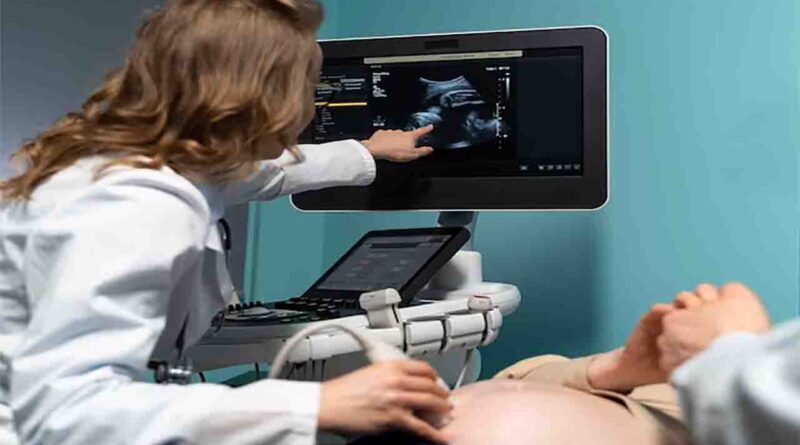How Many Ultrasounds Will I Have During My Pregnancy?
Ultrasound during pregnancy is an incredible journey filled with anticipation, wonder, and excitement. Throughout this nine-month adventure, prenatal care plays a vital role in ensuring the health and well-being of both the mother and the growing baby. One crucial aspect of prenatal care is the use of ultrasound scans during pregnancy. These non-invasive, painless procedures provide valuable insights into the development and progress of the baby, helping healthcare professionals monitor and ensure a safe pregnancy.
In this comprehensive guide, we will explore the role of ultrasounds during pregnancy, answering questions such as how many ultrasounds you can expect, what each type entails, and why they are essential for a healthy pregnancy.
Prenatal ultrasounds are a cornerstone of modern prenatal care, offering invaluable insights into the health and development of both the expectant mother and the growing baby. Let’s delve deeper into why these imaging tests are considered crucial during pregnancy:
Early Confirmation of Pregnancy
- Ultrasounds serve as one of the earliest confirmations of pregnancy. They can detect the presence of a gestational sac, providing concrete evidence of pregnancy even before other signs or symptoms may manifest.
- Establishing an estimated due date is another essential aspect. Knowing the due date helps healthcare providers plan and monitor the pregnancy, ensuring that both mother and baby receive the necessary care at the right times.
Monitoring Fetal Development
- Ultrasounds offer an unparalleled window into the womb, allowing healthcare professionals to closely monitor the baby’s growth and development.
- Detailed images provide crucial information, such as measurements of the fetus, the size of organs, and the development of limbs. This ensures that the baby is progressing as expected and helps identify any potential issues early on.
Comprehensive Health Assessment
- Prenatal ultrasounds play a vital role in assessing the overall health of both the mother and the baby.
- They help detect any abnormalities or anomalies that may require medical attention. For instance, they can reveal structural issues in the baby’s heart or spine, enabling early intervention and treatment planning.
- Ultrasounds also aid in monitoring specific maternal health conditions like preeclampsia or gestational diabetes, ensuring that appropriate measures are taken to safeguard the well-being of both the mother and the baby.
Determining Multiples
- Ultrasounds are exceptionally effective at determining whether a pregnancy involves multiples, such as twins, triplets, or more.
- This information is not only exciting for expectant parents but also crucial for healthcare providers to tailor their care plans accordingly, as multiple pregnancies often come with unique challenges and considerations.
In conclusion, prenatal ultrasounds are a multi-faceted tool that serves as a lifeline for expectant parents and healthcare providers alike. Beyond confirming pregnancy, they provide comprehensive insights into the health and development of both the mother and the baby. These ultrasound images represent more than just medical data; they symbolize the wondrous journey of bringing a new life into the world, making each prenatal ultrasound a cherished moment in the pregnancy experience.
Now, let’s explore the different types of ultrasounds you may encounter during your pregnancy:
Types of Pregnancy Ultrasounds
Prenatal ultrasounds are incredibly versatile, offering various techniques to gather essential information about the developing fetus. Here, we delve into the different types of pregnancy ultrasounds and their specific purposes:
1. Transvaginal Ultrasound
- Purpose: Transvaginal ultrasounds are typically performed in the early stages of pregnancy, often during the first trimester.
- Procedure: This procedure involves inserting a small, lubricated wand (transducer) into the vagina, which is closer to the uterus. This proximity provides clearer and more detailed images of the developing fetus.
- Common Uses: Transvaginal ultrasounds are valuable for confirming pregnancy, especially in the earliest weeks when other methods may not be as reliable. They are also used to check for ectopic pregnancies, where the embryo implants outside the uterus, and to assess early fetal development.
2. Abdominal Ultrasound
- Purpose: Abdominal ultrasounds are the most common type of prenatal ultrasound and are performed throughout pregnancy.
- Procedure: A transducer is moved gently across the mother’s abdomen, which is covered with a special gel to ensure optimal sound wave transmission. The transducer emits sound waves that bounce off structures inside the body, creating real-time images on a screen.
- Common Uses: Abdominal ultrasounds serve various purposes during pregnancy, including estimating the due date, monitoring fetal growth, evaluating the position of the placenta, assessing amniotic fluid levels, and examining maternal organs for any abnormalities.
3. Doppler Ultrasound
- Purpose: Doppler ultrasounds are specialized scans that focus on measuring blood flow, both in the baby’s vessels and the mother’s placenta.
- Procedure: Similar to abdominal ultrasounds, a Doppler transducer is used. However, it includes Doppler technology, which assesses blood flow by analyzing the frequency changes of sound waves bouncing off red blood cells.
- Common Uses: Doppler ultrasounds are particularly useful for assessing the well-being of the fetus. They help healthcare providers detect potential circulation issues, ensuring that the baby is receiving adequate oxygen and nutrients through the placenta.
4. 3D and 4D Ultrasound
- Purpose: These advanced imaging techniques provide three-dimensional and real-time views of the baby, offering a more detailed look at the fetus’s features.
- Procedure: 3D and 4D ultrasounds use the same principles as abdominal ultrasounds but with a specialized transducer capable of capturing multidimensional images. 3D ultrasounds create static, three-dimensional images, while 4D ultrasounds add the element of time, providing real-time video footage of the baby’s movements.
- Common Uses: While not typically part of routine prenatal care, 3D and 4D ultrasounds offer a unique and visually engaging experience for expectant parents who want a more detailed look at their baby’s facial features and movements. They are often used for bonding and creating memorable keepsakes.
The world of prenatal ultrasounds offers a range of techniques, each with its specific purpose and benefits. These ultrasounds serve as invaluable tools, providing healthcare providers and parents with essential information about the developing fetus, its health, and its progress throughout the pregnancy journey. Whether for early confirmation, growth monitoring, or the sheer joy of seeing your baby’s face, ultrasounds play a vital role in the prenatal experience.
Frequency of Ultrasounds During Pregnancy

The number and timing of ultrasounds during pregnancy can vary based on several factors, including your individual health, the stage of pregnancy, and any specific concerns. Here, we provide a comprehensive overview of the typical frequency of ultrasounds throughout the three trimesters of pregnancy and special circumstances:
First Trimester (Weeks 6-13)
- Confirmation of Pregnancy:
- The first ultrasound in the first trimester is often used to confirm pregnancy. It’s an exciting moment for many expectant parents as they get their first glimpse of the tiny developing fetus.
- Nuchal Translucency Scan (NT Scan):
- Usually performed around the 11th to 13th week, the NT scan assesses the risk of chromosomal abnormalities, such as Down syndrome. This non-invasive test measures the thickness of the fluid at the back of the baby’s neck.
Second Trimester (Weeks 14-26)
- Anatomy Scan (Around Week 20):
- The second trimester often includes a comprehensive ultrasound, known as the anatomy scan or level II ultrasound. This is a detailed examination that checks the baby’s organs, bones, and overall development.
- During this scan, healthcare providers assess the baby’s brain, heart, kidneys, spine, limbs, and more. It’s also an opportunity for gender determination if the parents wish to know.
Third Trimester (Weeks 27-40)
- Additional Scans for Specific Concerns:
- In the third trimester, the frequency of ultrasounds may vary based on individual circumstances and any concerns that arise.
- If there are concerns about fetal growth, amniotic fluid levels, or the position of the baby, additional ultrasounds may be recommended. These scans help monitor the baby’s well-being and guide decisions about delivery.
High-Risk Pregnancies
- More Frequent Monitoring:
- Women with high-risk pregnancies, which can be due to factors like advanced maternal age, medical history, or complications such as gestational diabetes or hypertension, may require more frequent ultrasounds.
- These additional scans help closely monitor both the mother’s and baby’s health and allow healthcare providers to make informed decisions about care and delivery.
Additional Scans
- Special Circumstances:
- Some expectant mothers may undergo additional ultrasounds based on specific circumstances. For instance, if there were early pregnancy complications or if a fetal abnormality is suspected, specialized scans may be performed to provide more information and guide treatment decisions.
It’s important to emphasize that ultrasounds are generally considered safe when performed by trained professionals and used appropriately. They provide critical information that aids in prenatal care, ensuring the best possible outcome for both the mother and the baby. Healthcare providers carefully assess the need for each ultrasound based on medical guidelines and individual patient needs, aiming to strike a balance between monitoring and minimizing unnecessary exposure to ultrasound waves.
Throughout your pregnancy journey, open communication with your healthcare provider is key. They will guide you on the appropriate number and timing of ultrasounds to ensure the health and well-being of both you and your baby. Remember, each ultrasound is a special opportunity to connect with your growing child and gain valuable insights into their development.
It’s essential to note that ultrasounds are generally safe when performed by trained professionals and used judiciously. They provide valuable information that aids in prenatal care, ensuring the best possible outcome for both mother and baby.
In the world of prenatal care, ultrasounds serve as windows into the miracle of pregnancy. They offer insights, reassurance, and the opportunity to bond with your unborn child. While the number of ultrasounds may vary, each one plays a vital role in monitoring the well-being of both the expectant mother and the developing baby.
As you embark on this incredible journey, remember that your healthcare provider is your trusted guide, ensuring that you receive the right number of ultrasounds tailored to your unique pregnancy. These tests offer a glimpse into the wondrous process of life, making your pregnancy an even more remarkable and cherished experience.




